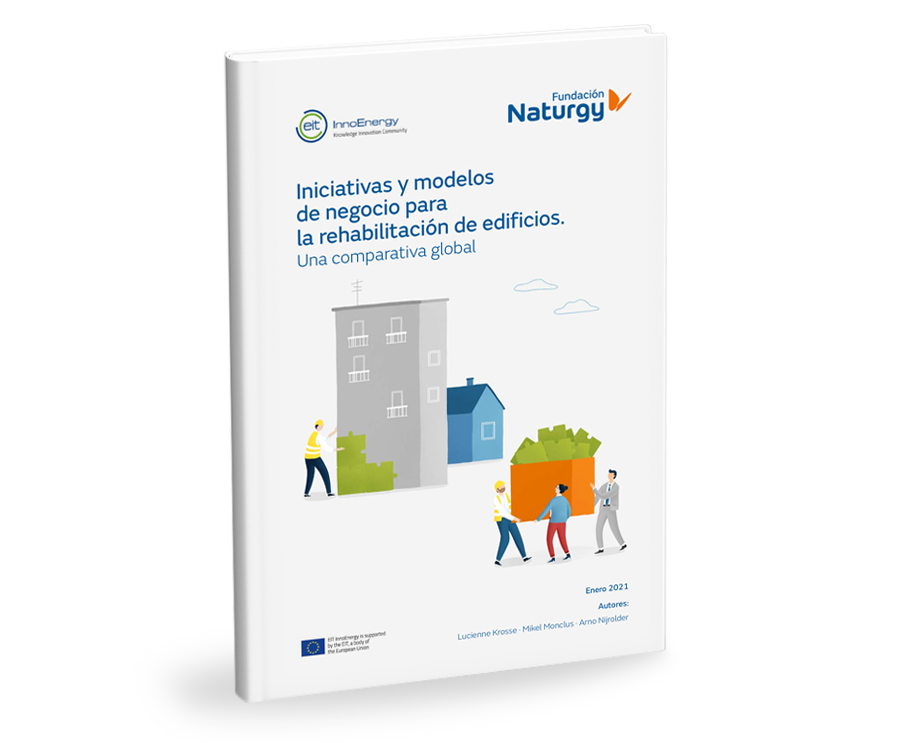Spain needs 25 times more building renovation to comply with the energy efficiency goals of the Green Deal
A study published by the Naturgy Foundation which analyses success stories in the United States, Australia and Europe concludes that the single point of contact format will make launching renovation projects easier.E
Europe has still not succeeded in achieving the pace of property renovation needed to be climate neutral in 2050, which is why energy renovation will be essential to improving energy efficiency and meeting climate goals.

The building renovation rate in Europe needs to be around 2–3% per year to meet climate neutral goals in 2050. However, the European average is currently 1% and Spain sits at the tail end of this ranking.
“The renovation rate in our country needs to be 25 times greater,” stated Mikel Lasa, chief executive officer for Spain and Portugal of EIT, InnoEnergy, today at the presentation of the report ‘Initiatives and Business Models for Building Renovation. A global comparison’, published by the Naturgy Foundation.
In turn, Juan Jacobo Llerena, deputy director-general of Energy Efficiency at the Ministry for the Ecological Transition and the Demographic Challenge (MITECO), explained that, “in Spain, we have old housing stock that is inefficient in terms of energy. Out of 20 million homes, 9.4 million need urgent refurbishment.” “Public–private collaboration and smart investment in the energy transition framework is needed,” he stated.
Maria Eugenia Coronado, managing director of the Naturgy Foundation, highlighted the importance of energy renovation “within the framework of energy transition and climate neutrality established by the European Green Deal, which has set some ambitious targets for efficiency and decarbonisation.”
A single point of contact: the most suitable model
The study by EIT, InnoEnergy, a benchmark European company in global energy innovation in Europe, analyses 16 energy renovation experiences in the United States, Australia and Europe, and concludes that the single point of contact model is the most suitable model to drive forward improvements in the efficiency of European buildings, 75% of which are inefficient in energy terms due to their age.
Housing stock is responsible for 40% of energy consumption in the EU, 36% of CO2 emissions and 55% of electricity consumption, according to the report. The study also states that over 40% of buildings were constructed before 1960 and 90% before 1990. This is why energy renovation, in which local government will play a decisive role, will be essential to achieve the decarbonisation established in the European Green Deal.
In the analysed models, “despite the variety of subsidies that promote energy efficiency, there is still limited implementation of deep-rooted, or even superficial, renovation,” due to the multiple barriers owners come up against: the complexity of the process, lack of knowledge about technical issues and little awareness of the benefits of renovation, in addition to the cost and inefficiencies in the market.
Fragmentation of the value chain: a barrier
“When the cases were analysed, it was noted that there are too many intermediaries and few trained professionals, as well as an excess of bureaucracy, which was frequently aggravated by a lack of continuity with regard to subsidies,” explained Lasa.
Various participants play a role in any renovation: owners, tenants, constructors, manufacturers, town halls and other public institutions, as well as energy suppliers. You have to coordinate with five, six or an even greater number of interested parties. It’s not just a matter of investment, but rather the fragmentation of the value chain which needs to be organised,” asserted Lucienne Krosse, manager of Sustainable Cities and Buildings at EIT, InnoEnergy.
According to Lasa, “there are interesting models, such as long-term energy supply contracts that capitalise on savings. With this formula, the owner isn’t confronted with the cost of the renovation at the start, they pay for it progressively through energy savings and a monthly payment that is similar to what they were paying before the renovation.”
The study shows that this type of model, based on a single point of contact, achieves the greatest success. Furthermore, the authors affirm that both energy suppliers and distributors, as well as governments, play a key role when it comes to identifying potential clients.
The document also advocates the development of collaborative platforms that companies traditionally in competition with one another can use to join forces, thereby reducing technical and financial risk and achieving better prices for owners.
In addition to the single point of contact model, the authors also highlight two other successful models: innovative financing plans that offer help with meeting the high initial costs, and models based on new income flows that involve reducing taxes or incentives.
Mar Blázquez, deputy assistant director of Energy Efficiency at MITECO, also participated in presenting the study and explained that, “we have two big challenges to driving forward energy renovation: boosting demand in the face of the multiple barriers that slow down the rate of renovation, and integrating particularly unbundled services into the market.”
In turn, Sigfrido Herráez, chairman of the Madrid College of Architects, explained that, “we have created a renovation office as a one-stop shop for developing this type of project. There is a clear niche for this work and we are going to encourage specific training”.
Roberto Colomer, CEO of Unión de Créditos Inmobiliarios (UCI), stated that “full digitalisation of all the information is needed, in a way that is sustained over time and includes all the participants in the renovation process, to be able to determine what is and what isn’t green investing, which is also very important to economic recovery and job creation”.
Share